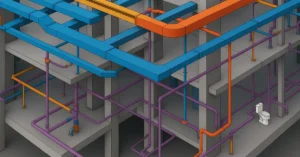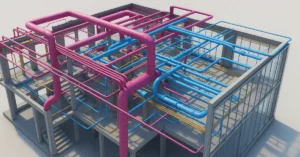Unlocking the Full Potential of BIM in Brazil’s Urban Revolution
Urban development in Brazil, one of the most dynamic and rapidly urbanizing countries in Latin America, presents both significant challenges and opportunities. With a population exceeding 210 million people and an economy that ranks among the largest in the world, Brazil’s urban landscapes are continuously evolving. However, this growth comes with a myriad of issues, including inadequate infrastructure, housing shortages, and environmental concerns. Building Information Modeling (BIM) has emerged as a transformative tool in addressing these challenges and enhancing urban development processes in Brazil.
Understanding BIM
Building Information Modeling (BIM) is a digital representation of the physical and functional characteristics of a facility. It serves as a shared knowledge resource for information about a facility, forming a reliable basis for decisions during its lifecycle from inception onward. The adoption of BIM involves creating and managing digital models that encompass both geometric and non-geometric data, allowing for more effective planning, design, construction, and management of buildings and infrastructure.
The Importance of Urban Development in Brazil
Urban development is critical to Brazil’s socio-economic growth. Major cities like São Paulo, Rio de Janeiro, and Brasília are not only economic powerhouses but also cultural hubs. The rapid urbanization rate necessitates the development of sustainable and efficient infrastructure to accommodate the growing population. However, urban development in Brazil is plagued by issues such as inadequate transportation systems, insufficient housing, and lack of basic amenities in many urban areas. This scenario calls for innovative solutions that can streamline the planning and implementation processes, making them more efficient and sustainable.
BIM in Brazil’s Urban Development
- Enhanced Project Visualization and Planning BIM allows for the creation of highly detailed 3D models that provide a visual representation of buildings and infrastructure projects. In Brazil, this capability is crucial for urban planning as it enables stakeholders to visualize the end product, understand spatial relationships, and make informed decisions early in the project lifecycle. For instance, in the redevelopment of the Porto Maravilha area in Rio de Janeiro, BIM was used to create comprehensive models that helped in planning the new urban infrastructure, integrating various elements like roads, public spaces, and buildings.
- Improved Collaboration and Communication One of the significant advantages of BIM is its ability to enhance collaboration among different stakeholders. In Brazil, where urban development projects often involve multiple entities, effective communication is vital. BIM facilitates the sharing of information in a centralized manner, ensuring that architects, engineers, contractors, and government officials are on the same page. This collaborative environment reduces the likelihood of errors and discrepancies, leading to more efficient project execution.
- Cost and Time Efficiency Traditional construction methods often lead to cost overruns and delays, issues that are prevalent in Brazil’s urban development projects. BIM helps mitigate these problems by enabling more accurate cost estimation and project scheduling. The use of BIM in the construction of the São Paulo Metro Line 6, for example, allowed for detailed planning and simulation of construction activities, identifying potential bottlenecks and optimizing resource allocation. This proactive approach resulted in significant cost savings and timely project completion.
- Sustainability and Environmental Impact Sustainability is a critical concern in Brazil’s urban development, given the environmental challenges the country faces. BIM supports sustainable design and construction practices by allowing for the analysis of energy performance, material usage, and environmental impact. In the development of the Cidade Matarazzo complex in São Paulo, BIM was used to model energy-efficient systems and sustainable building materials, contributing to the project’s LEED certification. This emphasis on sustainability helps in creating urban environments that are not only functional but also environmentally responsible.
- Regulatory Compliance and Risk Management Urban development projects in Brazil must comply with a complex web of regulations and standards. BIM aids in ensuring that these projects meet all regulatory requirements by providing a comprehensive view of compliance issues early in the design phase. Furthermore, BIM enhances risk management by allowing for the identification and mitigation of potential risks throughout the project lifecycle. This proactive risk management is particularly important in Brazil, where regulatory and environmental considerations can significantly impact project timelines and costs.
- Maintenance and Facility Management The benefits of BIM extend beyond the construction phase, providing valuable tools for the maintenance and management of urban infrastructure. The digital models created during the design and construction phases serve as a reliable source of information for facility management, ensuring that buildings and infrastructure are maintained efficiently. In Brazil, where aging infrastructure is a concern, the implementation of BIM for maintenance purposes can lead to improved asset management and extended lifecycle of urban facilities.
Case Studies: BIM in Action in Brazil
- Porto Maravilha, Rio de Janeiro The Porto Maravilha project is one of the largest urban redevelopment initiatives in Brazil. It aimed to revitalize the port area of Rio de Janeiro, transforming it into a modern urban space with residential, commercial, and cultural facilities. BIM was integral to this project, providing detailed models that facilitated the planning and integration of various infrastructure components. The use of BIM allowed for better coordination among stakeholders, accurate cost estimation, and effective management of construction activities, resulting in a successful transformation of the area.
- São Paulo Metro Line 6 The construction of the São Paulo Metro Line 6 is a significant urban development project aimed at improving the city’s transportation network. BIM played a crucial role in this project by enabling detailed planning and simulation of construction processes. The digital models created through BIM helped in identifying potential challenges and optimizing resource allocation, leading to cost savings and timely completion of the project. The success of this project underscores the potential of BIM in enhancing the efficiency and effectiveness of urban infrastructure development in Brazil.
- Cidade Matarazzo, São Paulo Cidade Matarazzo is a mixed-use development project in São Paulo that aims to blend modern architecture with historical preservation. BIM was used extensively in this project to model energy-efficient systems and sustainable building materials. The digital models facilitated the integration of various design elements, ensuring that the project met sustainability standards and received LEED certification. This project highlights the role of BIM in promoting sustainable urban development in Brazil.
Challenges in BIM Adoption in Brazil
While BIM offers significant advantages for urban development, its adoption in Brazil faces several challenges. These include:
- Lack of Standardization The absence of standardized BIM protocols and guidelines in Brazil can lead to inconsistencies and hinder effective collaboration among stakeholders. Developing and implementing national BIM standards is crucial for ensuring uniformity and efficiency in urban development projects.
- Training and Education There is a need for comprehensive training and education programs to equip professionals with the necessary skills to use BIM effectively. Investing in education and continuous professional development is essential for the widespread adoption of BIM in Brazil’s urban development sector.
- Initial Investment The implementation of BIM requires a significant initial investment in software, hardware, and training. While the long-term benefits of BIM are substantial, the upfront costs can be a barrier for smaller firms and government entities with limited budgets.
- Cultural Resistance Resistance to change is a common challenge in the adoption of new technologies. In Brazil, some stakeholders may be hesitant to transition from traditional construction methods to BIM-based approaches. Addressing this resistance through awareness campaigns and demonstrating the benefits of BIM is crucial for its successful adoption.
Future Prospects of BIM in Brazil’s Urban Development
Despite these challenges, the future of BIM in Brazil’s urban development looks promising. The government’s increasing recognition of the importance of BIM, coupled with the private sector’s growing interest in innovative construction technologies, is driving the adoption of BIM. Several initiatives, such as the creation of the BIM BR Strategy, aim to promote the use of BIM in public projects and establish national standards for its implementation.
As Brazil continues to urbanize and modernize its infrastructure, the adoption of BIM will play a crucial role in shaping the country’s urban landscapes. By enhancing project visualization, improving collaboration, reducing costs, promoting sustainability, and ensuring regulatory compliance, BIM can significantly contribute to the development of efficient, sustainable, and resilient urban environments in Brazil.
Conclusion
Building Information Modeling (BIM) is revolutionizing urban development in Brazil, addressing critical challenges and transforming the way infrastructure projects are planned, designed, and managed. From enhancing project visualization and collaboration to promoting sustainability and ensuring regulatory compliance, BIM offers numerous benefits that are essential for the efficient and sustainable development of urban areas. Despite the challenges in its adoption, the future of BIM in Brazil’s urban development is bright, promising significant improvements in the planning, execution, and maintenance of urban infrastructure. As Brazil continues to embrace this innovative technology, the potential for creating modern, sustainable, and resilient urban environments becomes increasingly achievable.
If you’re interested in learning more about architecture firms in Europe, check out this comprehensive list of the top 50 firms compiled by Archgyan. From innovative startups to long-established industry leaders, this list has it all. Take a look and discover some of the most inspiring and influential architecture firms in Europe today.
If you’re interested in architecture and want to learn more about this amazing field, subscribe to our podcast on youtube
For more SketchUp tutorials, head to https://www.sketchupguru.com










